Over time, UC's varied sources of revenue have grown at different rates.
12.1.1 Revenues by source, Universitywide, Fiscal year 2022–23
![]()
Overview
UC requires significant resources and planning to support its instruction, research, and public service missions. This chapter provides insight into the financial health of the University, the state of capital and space resources, and the environmental sustainability of campus operations. This chapter also includes information on the UC Community Safety Plan, which re-envisions safety at University of California locations.
Indicators in this chapter provide updates on the following topics:
Finances (12.1)
The University’s operating budget funds its mission of teaching, research, and public service, as well as a wide range of support activities, including teaching hospitals, the Lawrence Berkeley National Laboratory, UC Extension, housing and dining services, libraries, and other functions. State General Funds remain extremely important as they support the University’s core instructional mission and make it possible to attract funds from other sources. Other fund sources augment the University’s core activities of instruction and research; support academic and administrative functions; allow UC to provide public service to the State and its people; and support rich social, cultural, and learning environments on its campuses. Finance indicators provide updates on UC revenues, gift funds, expenditures, and core fund expenditures for instruction.
Capital Projects (12.2)
UC has three broad capital program categories: Campus Education and General, Campus Auxiliary Enterprises, and Medical Centers. In general, Education and General projects do not have a revenue stream, contributing to its capital program having a significant funding shortfall. Auxiliary enterprises have revenue streams, but while still recovering from the substantial financial loss amid COVID-19, the enterprises’ capital program cannot provide enough housing to meet demand. UC medical centers’ capital program has increased to support the continued excellence of UC Health and its public service commitment to improving the health and well-being of all people in California. Capital projects indicators detail UC’s sources of capital funding and spending, capital project types, and increases in space for various uses.
Sustainability (12.3)
The University of California’s formal sustainability commitments began in 2003 with a Regental action that led to the adoption of the Presidential Policy on Green Building Design and Clean Energy Standards in 2004. Since then, UC has expanded the scope of the Sustainable Practices Policy to include climate, transportation, building operations, waste, procurement, food, water, health and well-being, UC Health and sustainability performance, as well as anti-racism, diversity, equity and inclusion. Sustainability indicators provide updates on UC’s progress in reducing greenhouse gas emissions, improving energy efficiency, and increasing LEED® certified green building projects. UC’s progress on sustainability is further detailed in the University of California Sustainability Annual Report 2023.
Community safety (12.4)
The UC Community Safety Plan re-envisions safety at the University of California locations and calls for transforming UC’s culture, policies, and practices to ensure that all members of the community feel welcomed, respected, and protected from harm. Community Safety indicators provide aggregate figures on the number of UCPD stops, use of force incidents, calls for service, criminal activity reports, and civilian complaints.
Over time, UC's varied sources of revenue have grown at different rates.
12.1.1 Revenues by source, Universitywide, Fiscal year 2022–23
![]()
Of the $3.1 billion in gift funds, 99 percent are restricted by donors in how they may be used.
12.1.2 Current giving by purpose, Universitywide, 2000–01 to 2022–23
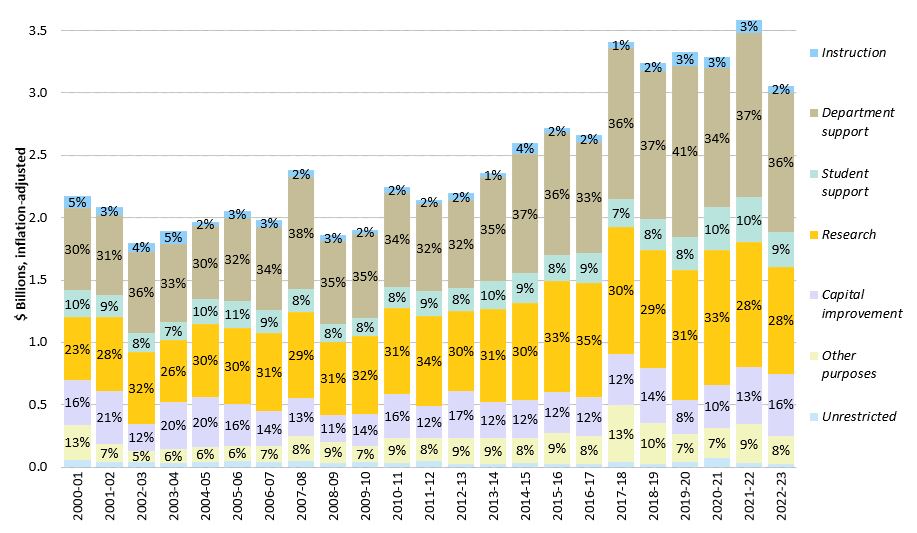
source: UC Institutional Advancement
Gift funds have become increasingly important to the University as a means to help address budget shortfalls and expand student financial aid. In 2022–23, new gifts to the University totaled nearly $3.1 billion. However, virtually all of these funds are restricted for specific purposes and are not available to support general operating costs. In addition, approximately $625 million was designated for endowment, where only the income/payout is available for expenditure.
Private giving varies significantly by campus and relates to the campus’ age, number of alumni, and the presence of health science programs.
Medical centers are the largest single functional expense, and their share has grown over the last two decades.
12.1.3 Expenditures by function and class, Universitywide, Fiscal year 2022–-23
![]()
Revenue and expense data dashboard
Revenue and expense data dashboard
Average instructional expenditures per UC student increased 4.5% from 2010-11 to 2022-23, largely driven by increases in nonresident supplemental tuition.
12.1.4 Average general campus core fund expenditures for instruction per student, 2000–01 to 2021–22
![]()
University of California Budget for Current Operations 2024-25 report | page 19
source: UC Budget Office
Ninety-one percent of UC’s capital project funding over the last ten years was derived from non-State fund sources. In 2013–14, changes to the California Education Code allowed UC to direct a portion of its existing State operating funds support to capital.
12.2.1 Sources of capital project funding by year of approval, Universitywide, 2013–14 to 2022–23

source: UC Capital Asset Strategies
The University’s capital program is driven by the campuses’ and medical centers’ strategic plans. UC’s capital program is funded by a combination of State and non-State funds, with non-State sources funding most of UC’s State-eligible capital needs and all self-supporting enterprises, such as housing, parking, athletics, and medical centers. To the extent that non-State funds are used to support core academic capital needs, less funding is available to support other high-priority needs such as deferred maintenance, seismic, and enrollment growth.
The 2022–23 capital project program is heavily supported by external financing.
12.2.2 Sources of capital project spending detail, Universitywide, Project budgets approved in 2022–23

source: UC Capital Asset Strategies
External financing is a crucial component in supporting UC’s capital outlay. In 2022-23, 58 percent of the funding was sourced from non-State supported external financing. Most of this financing supported the construction of student housing projects (auxiliary). The non-State financing also supported medical center construction as well as renewal and modernization of instructional and research space and program improvements (education and general).
The remainder of UC’s capital program is funded by gift funds, campus funds, and other non-State sources. These campus funds are derived from various sources, including indirect cost recovery and investment earnings.
Ninety-two percent of capital funds approved for expenditure in 2022–23 supported program improvements and projects addressing enrollment growth.
12.2.3 Types of capital projects, based on budgets approved by year, Universitywide, 2013–14 to 2022–23
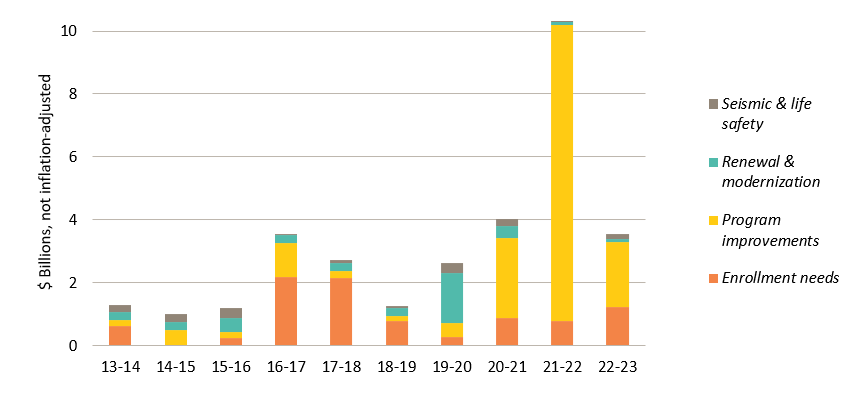
source: UC Capital Asset Strategies
Program improvements and modern program initiatives require state-of-the-art space, often necessitating the repurposing of existing facilities or new construction. During 2022-23, UC approved capital project budgets totaling $3.6 billion.
The capital outlay supported a variety of projects with $2.1 billion for program improvements. A significant portion of the program improvements investment (59 percent) supported two campus projects (UCB Gateway New Academic Building and UCSD Triton Center) and a medical center project (UCLA Neuropsychiatric Hospital).
Additionally, UC approved $1.2 billion for projects focused on meeting the demands of increasing enrollments, with the majority directed towards expanding student housing. Notably, 54 percent of these funds supported a UCSD housing project (Ridge Walk North Living and Learning Neighborhood).
The remaining $270 million supported projects that addressed renewal and modernization as well as seismic and life safety.
UC space has increased by 15 percent in the past decade, with most of the growth targeted for instruction and research and residential uses.
12.2.4 Assignable square footage (ASF), Universitywide, 2013–2023

source: UC Capital Asset Strategies
Assignable square footage (ASF) is the space available for programs or assigned to specific uses. It does not include corridors, bathrooms, or building infrastructure. Indicator 12.2.4 illustrates the growth in space over the last decade, according to categories for assignable space. Since 2013, space has increased by 11.3 million ASF to 85.2 million ASF.
In the past decade, instructional and research space increased by about 1.7 million ASF, office space by 2.1 million ASF, and residential space by 5.1 million ASF. The space increase for these areas (17 percent) has not kept pace with the increase in fall enrollment (24 percent) for the same period. Residential space has grown as campuses strive for more on-campus student housing to improve student life in living/learning communities and to reduce environmental impacts from commuting. Increases in the student population have also required additional athletic, recreational, and food service space.
The lack of affordable housing is a problem in California and the nation. The University of California is working diligently to identify ways to support students with their housing. The University continues to access sources of funding to help with the development of affordable housing for UC’s student population. The University was successful in its application through the State of California’s 2022-23 Higher Education Student Housing Grant program, receiving $389 million for the construction of beds to support the lowest-income students.
Hospital space has also grown in the past decade. All five medical centers experienced growth, but most of the growth in hospital space can be attributed to UCSF Medical Center at Mission Bay (2015) and Ron Conway Family Gateway Medical Building (2015), and the Jacobs Medical Center (2016) and Koman Family Outpatient Pavilion (2018) at UC San Diego Health.In July 2023, UC adopted stronger climate policy goals focused on direct action to reduce greenhouse gas emissions 90 percent from 2019 levels by 2045 with residual emissions negated by carbon removal.
12.3.1 Greenhouse gas emissions compared to climate goals, Universitywide, 2009–2045
![]()
University of California Sustainability Annual Report 2023 – Policy progress: Climate
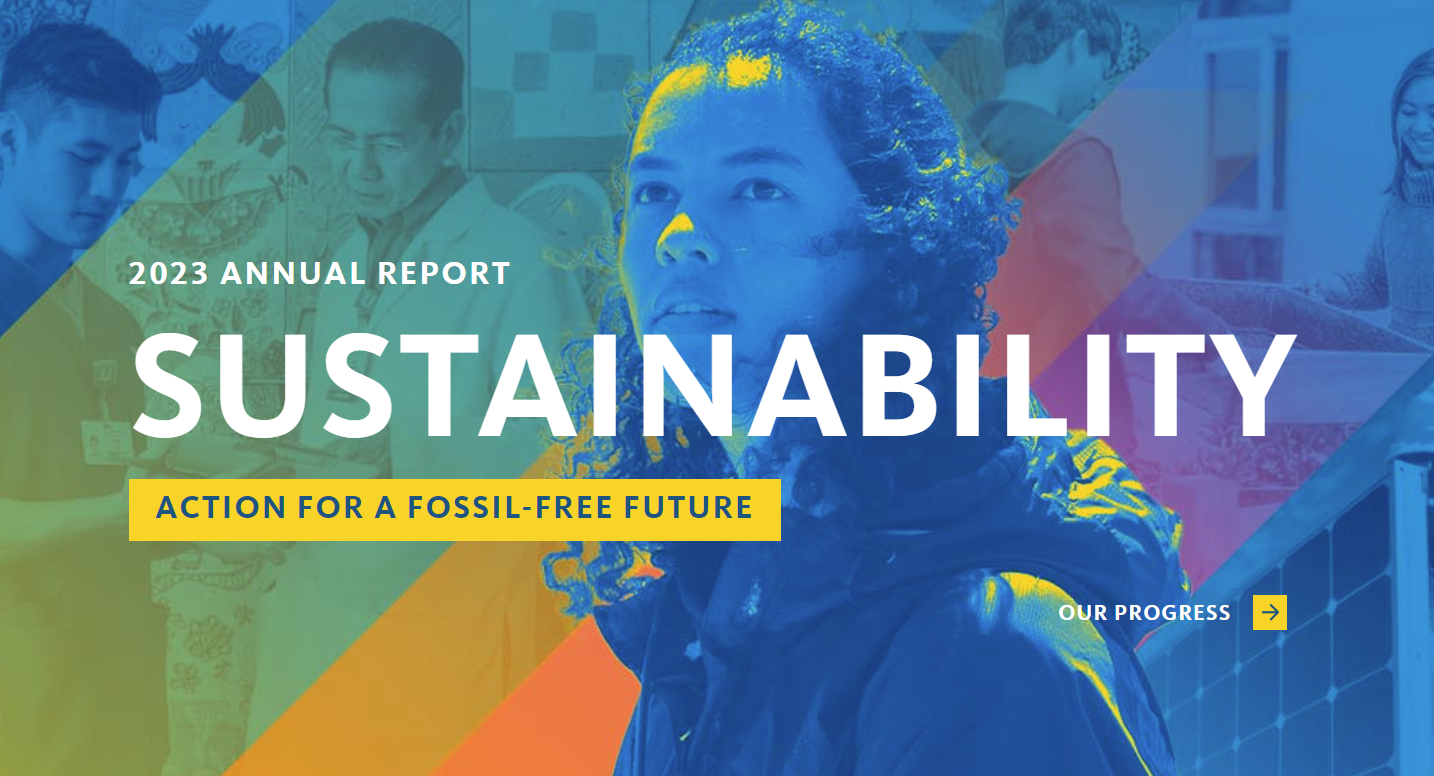
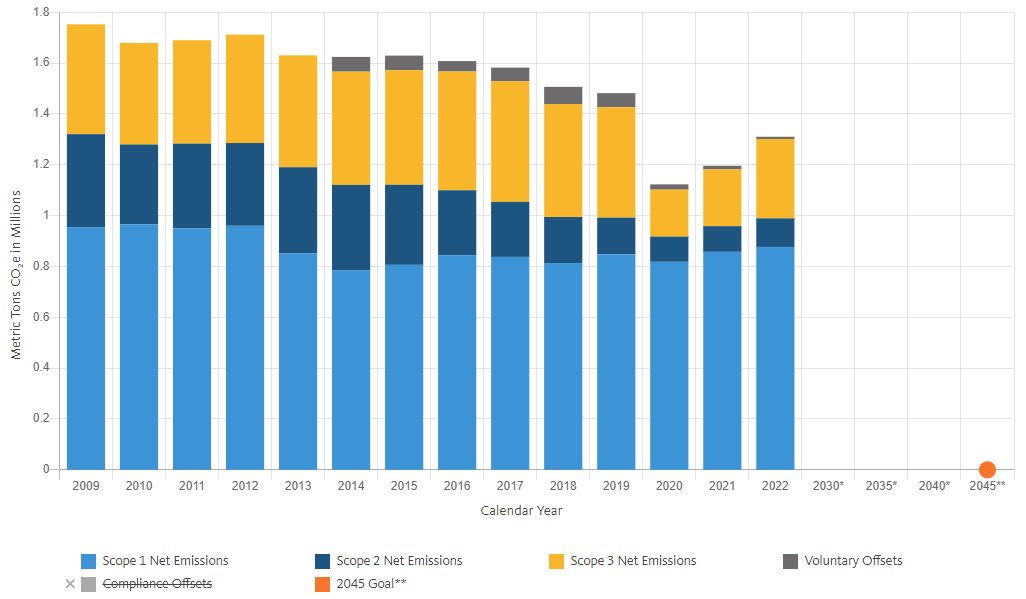
source: UCOP Energy and Sustainability Office
Notes:
- Excludes ANR, LBNL, and UCOP
- Voluntary offsets are no longer used for policy compliance. Future versions of this graph will reintegrate them into UC’s emissions profile.
- Interim goals for 2030, 2035, and 2040 to be developed through fossil-free planning that is underway at each location
- 90% direct reduction of total emissions from 2019 levels with residual emissions negated by carbon removal
In 2022, UC locations continued their energy efficiency efforts while working to retain the energy use reductions realized from the COVID-19 pandemic, now with increased occupancy and campus activity, resulting in flat year-over-year performance.
12.3.2 Energy costs savings and energy use intensity, Universitywide, 2009–2022
![]()
University of California Sustainability Annual Report 2023 – Policy Progress: Energy

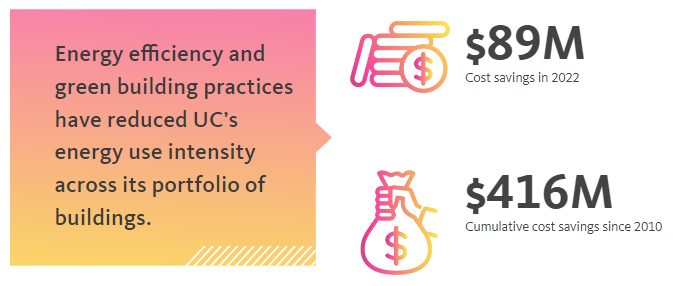
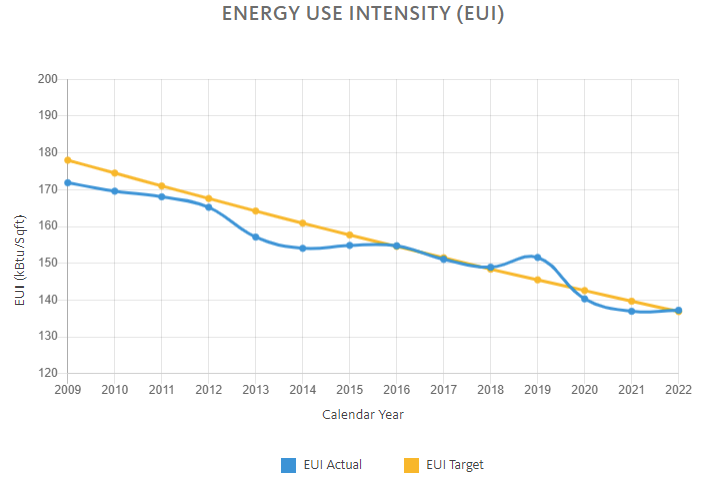
source: UCOP Energy and Sustainability Office
By mid-2023, UC had achieved 427 LEED® certifications.
12.3.3 LEED® certifications, Universitywide, 2002–2023 (cumulative)
![]()
University of California Sustainability Annual Report 2023 – Policy Progress: Green Building

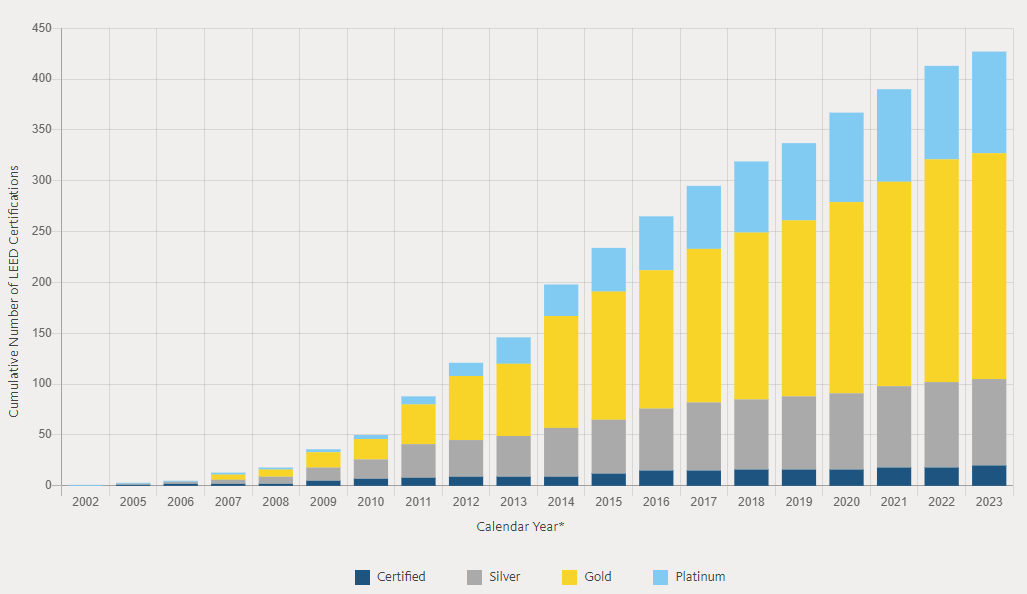
source: UCOP Energy and Sustainability Office
UC police departments made 15,000 stops in 2023.
12.4.1 Number and circumstances of UCPD stops by month, Universitywide, 2023
![]()
Community safety: Stops dashboard
source: Quarterly data submissions from UC police departments
Most of the stops originated from a traffic violation and the majority of all stops resulted in a warning. The dashboard linked above provides additional information on the reason for and result of UC police department stops by campus and perceived race/ethnicity.
There were 129 use of force incidents in 2023, and 112 in 2022.
12.4.2 Number of UCPD use of force incidents by month, Universitywide, 2023
![]()
Community safety: Use of force dashboard
source: Quarterly data submissions from UC police departments
The majority of use of force incidents were preceded by a call for service and resulted in the use of a physical technique. The dashboard linked above provides additional information about use of force incidents by campus and race/ethnicity.
While the reporting of use of force is not consistent across campuses, UCPD Chiefs are currently working on a consistent reporting approach.
There were over 425,000 calls for service to UC police departments throughout 2023, a 12 percent over the prior year.
12.4.3 Number of UCPD calls for service by call category, Universitywide, 2023
![]()
Community safety: Calls for service dashboard
source: Quarterly data submissions from UC police departments
The majority of calls for service were for security services such as building check, security check, patrol check, escorts, etc. The dashboard linked above provides additional information about calls for service by campus.
There were approximately 11,800 reports of criminal activities/offenses and over 2,700 arrests in 2023.
12.4.4 Number of UCPD criminal activity reports/offenses by month, Universitywide, 2023
![]()
Community safety: Crimes dashboard
source: Quarterly data submissions from UC police departments
The majority of criminal activity reports were for offenses such as larceny/theft, vandalism, motor vehicle theft, assault, etc. The dashboard linked above includes additional data on criminal activity reports by type of criminal activity and campus.
Group A: Under the National Incident-Based Reporting System (NIBRS), Group A offenses include, but are not limited to: Human trafficking, homicide, assault, larceny/theft, bribery, burglary/B&E, destruction/damage/vandalism of property, drug/narcotic offenses, pornography/obscene material offenses, embezzlement, prostitution offenses, extortion/blackmail, fraud, robbery, gambling offenses, stolen property, etc.
Group B: Under NIBRS, Group B offenses include, but are not limited to: Bad checks, curfew/loitering/vagrancy violations, disorderly conduct, driving under the influence, drunkenness, nonviolent family offenses, liquor law violations, peeping tom, trespassing, etc.
A full list of Group A and Group B offenses begin on page 10 of the NIBRS user manual
There were 17 civilian complaints against UC police officers in 2023 and nine in 2022.
12.4.5 Number of UCPD civilian complaints by month, Universitywide, 2023
![]()
Community safety: Civilian complaints dashboard
source: Quarterly data submissions from UC police departments
The majority of civilian complaints stemmed from allegations of unprofessional conduct and other unethical behavior. The dashboard linked above provides additional information on the circumstances and results of civilian complaints by campus.
Finances
Annual Financial reports (website)
Annual Financial reports (Medical Centers) (website)
Annual reports on University private support (website)
UC’s Operating Budget (website)
Capital Projects
Annual Major Capital Projects report (website)
Capital Financial Plan (website)
UC's capital planning (website)
UC’s capital programs (website)
Sustainability
Annual Sustainability reports (website)
2023 Annual Sustainability report – Policy Progress (website)
Information on UC’s sustainability (website)
UC Community Safety
UC Community Safety Plan (website)
Update on the implementation progress of the UC community Safety Plan (November 2022) (pdf)
UC community safety dashboards
The complete UC Information Center Institutional measures subject area.
The complete UC Information Center UC 2030 goals subject area.
The complete UC Information Center UC by the numbers subject area.
Download data tables for chapter 12 indicators (Excel format)